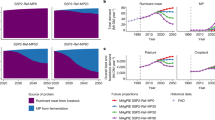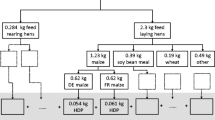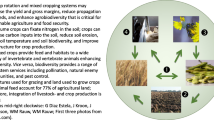Abstract
Multiple production and demand side measures are needed to improve food system sustainability. This study quantified the theoretical minimum agricultural land requirements to supply Western Europe with food in 2050 from its own land base, together with GHG emissions arising. Assuming that crop yield gaps in agriculture are closed, livestock production efficiencies increased and waste at all stages reduced, a range of food consumption scenarios were modelled each based on different ‘protein futures’. The scenarios were as follows: intensive and efficient livestock production using today’s species mix; intensive efficient poultry–dairy production; intensive efficient aquaculture–dairy; artificial meat and dairy; livestock on ‘ecological leftovers’ (livestock reared only on land unsuited to cropping, agricultural residues and food waste, with consumption capped at that level of availability); and a ‘plant-based eating’ scenario. For each scenario, ‘projected diet’ and ‘healthy diet’ variants were modelled. Finally, we quantified the theoretical maximum carbon sequestration potential from afforestation of spared agricultural land. Results indicate that land use could be cut by 14–86 % and GHG emissions reduced by up to approximately 90 %. The yearly carbon storage potential arising from spared agricultural land ranged from 90 to 700 Mt CO2 in 2050. The artificial meat and plant-based scenarios achieved the greatest land use and GHG reductions and the greatest carbon sequestration potential. The ‘ecological leftover’ scenario required the least cropland as compared with the other meat-containing scenarios, but all available pasture was used, and GHG emissions were higher if meat consumption was not capped at healthy levels.


Similar content being viewed by others
References
Albanito F, Beringer T, Corstanje R, Poulter B, Stephenson A, Zawadzka J, Smith P (2015) Carbon implications of converting cropland to bioenergy crops or forest for climate mitigation: a global assessment. GCB Bioenergy 8(1):81–95. doi:10.1111/gcbb.12242
Alexandratos N, Bruinsma J (2012) World agriculture towards 2030/2050. The 2012 revision. Food and Agriculture Organization of the United Nations, Rome
Andersen E, Baldock D, Bennet H, Beaufoy G, Bignal E, Brower F, Elbersen B, Eiden G, Godeschalk F, Jones G, McCracken DI, Nieuwenhuizen W, van Eupen M, Hennekes S, Zervas G (2003) Developing a high nature value farming area indicator. Consultancy report to the EEA. European Environment Agency, Copenhagen
Bajželj B, Richards KS, Allwood JM, Smith P, Dennis JS, Curmi E, Gilligan CA (2014) Importance of food-demand management for climate mitigation. Nat Clim Change 4(10):924–929. doi:10.1038/nclimate2353
Bennetzen EH, Smith P, Porter JR (2016) Decoupling of greenhouse gas emissions from global agricultural production: 1970–2050. Glob Change Biol 22(2):763–781. doi:10.1111/gcb.13120
Bryngelsson D, Wirsenius S, Hedenus F, Sonesson U (2016) How can the EU climate targets be met? A combined analysis of technological and demand-side changes in food and agriculture. Food Policy 59:152–164. doi:10.1016/j.foodpol.2015.12.012
Burney JA, Davis SJ, Lobell DB (2010) Greenhouse gas mitigation by agricultural intensification. Proc Natl Acad Sci 107(26):12052–12057. doi:10.1073/pnas.0914216107
de Ruiter H, Macdiarmid JI, Matthews RB, Kastner T, Smith P (2016) Global cropland and greenhouse gas impacts of UK food supply are increasingly located overseas. J R Soc Interface. doi:10.1098/rsif.2015.1001
EC (2011) A roadmap for moving to a competitive low carbon economy in 2050: COM (2011) 112 final. European Commission, Brussels
EC (2015) The early years: establishment of the CAP. European Commission. http://ec.europa.eu/agriculture/cap-history/early-years/index_en.htm. Accessed 4 May 2016
Eurostat (2007) The use of plant protection products in the European Union data 1992–2003: 2007 revision. European Commission, Brussels
FAO (2011) Global food losses and food waste—extent causes and prevention. Food and Agriculture Organization of the United Nations, Rome
FAO (2015a) FAO geonetwork. Find and analyze geo-spatial data. Food and Agriculture Organization of the United Nations, Rome. http://www.fao.org/geonetwork. Accessed 2 Feb 2015
FAO (2015b) FAOSTAT. Food and Agriculture Organization of the United Nations, Rome. http://faostat.fao.org/default.aspx. Accessed 6 Mar 2015
Foley JA, Ramankutty N, Brauman KA, Cassidy ES, Gerber JS, Johnston M, Mueller ND, O’Connell C, Ray DK, West PC, Balzer C, Bennett EM, Carpenter SR, Hill J, Monfreda C, Polasky S, Rockström J, Sheehan J, Siebert S, Tilman D, Zaks DPM (2011) Solutions for a cultivated planet. Nature 478(7369):337–342
Forster P, Ramaswamy V, Artaxo P, Berntsen T, Betts R, Fahey DW, Haywood J, Lean J, Lowe DC, Myhre G, Nganga J, Prinn R, Raga G, Schulz M, Van Dorland R (2007) Changes in atmospheric constituents and in radiative forcing. In: Solomon S, Qin D, Manning M, Chen Z, Marquis M, Averyt KB, Tignor M, Miller HL (eds) Climate change 2007: the physical science basis, contribution of working group I to the fourth assessment report of the intergovernmental panel on climate change. Cambridge University Press, Cambridge
Francis C, Lieblein G, Gliessman S, Breland TA, Creamer N, Harwood R, Salomonsson L, Helenius J, Rickerl D, Salvador R, Wiedenhoeft M, Simmons S, Allen P, Altieri M, Flora C, Poincelot R (2003) Agroecology: the ecology of food systems. J Sustain Agric 22(3):99–118. doi:10.1300/J064v22n03_10
Garnett T (2009) Livestock-related greenhouse gas emissions: impacts and options for policy makers. Environ Sci Policy 12(4):491–503. doi:10.1016/j.envsci.2009.01.006
Garnett T (2011) Where are the best opportunities for reducing greenhouse gas emissions in the food system (including the food chain)? Food Policy 36(SUPPL, 1):S23–S32
Garnett T (2015) Gut feelings and possible tomorrows: (where) does animal farming fit? Food climate research network. University of Oxford, Oxford
Garnett T, Röös E, Little D (2015) Lean green mean obscene…? What is efficiency? And is it sustainable? Food climate research network. University of Oxford, Oxford
Godfray C, Beddington JR, Crute IR, Haddad L, Lawrence D, Muir JF, Pretty J, Robinson S, Thomas SM, Toulmin C (2010) Food security: the challenge of feeding 9 billion people. Science 327(5967):812–818. doi:10.1126/science.1185383
Hallström E, Carlsson-Kanyama A, Börjesson P (2015) Environmental impact of dietary change: a systematic review. J Clean Prod 91:1–11. doi:10.1016/j.jclepro.2014.12.008
Havlík P, Valin H, Herrero M, Obersteiner M, Schmid E, Rufino MC, Mosnier A, Thornton PK, Böttcher H, Conant RT, Frank S, Fritz S, Fuss S, Kraxner F, Notenbaert A (2014) Climate change mitigation through livestock system transitions. Proc Natl Acad Sci 111(10):3709–3714. doi:10.1073/pnas.1308044111
Hedenus F, Wirsenius S, Johansson DA (2014) The importance of reduced meat and dairy consumption for meeting stringent climate change targets. Clim Change 124(1–2):79–91. doi:10.1007/s10584-014-1104-5
Hess T, Andersson U, Mena C, Williams A (2015) The impact of healthier dietary scenarios on the global blue water scarcity footprint of food consumption in the UK. Food Policy 50:1–10. doi:10.1016/j.foodpol.2014.10.013
Hoolohan C, Berners-Lee M, McKinstry-West J, Hewitt CN (2013) Mitigating the greenhouse gas emissions embodied in food through realistic consumer choices. Energy Policy 63:1065–1074. doi:10.1016/j.enpol.2013.09.046
Hötzel MJ (2014) Improving farm animal welfare: is evolution or revolution needed in production systems? In: Appleby MC, Weary DM, Sandoe P (eds) Dilemmas in animal welfare. CABI, Wallingford
IPCC (2006) 2006 IPCC guidelines for national greenhouse gas inventories. Intergovernmental Panel on Climate Change, Geneva
Kleijn D, Kohler F, Báldi A, Batáry P, Concepción ED, Clough Y, Díaz M, Gabriel D, Holzschuh A, Knop E, Kovács A, Marshall EJP, Tscharntke T, Verhulst J (2009) On the relationship between farmland biodiversity and land-use intensity in Europe. Proc R Soc B 276:903–909
Little DC, Murray FJ, Azim E, Leschen W, Boyd K, Watterson A, Young JA (2008) Options for producing a warm-water fish in the UK: limits to “green growth”? Trends Food Sci Technol 19(5):255–264. doi:10.1016/j.tifs.2007.12.003
Millward JD, Garnett T (2010) Plenary lecture 3 food and the planet: nutritional dilemmas of greenhouse gas emission reductions through reduced intakes of meat and dairy foods. Proc Nutr Soc 69(01):103–118. doi:10.1017/S0029665109991868
Mueller ND, Gerber JS, Johnston M, Ray DK, Ramankutty N, Foley JA (2012) Closing yield gaps through nutrient and water management. Nature 490(7419):254–257
NEF (2012) Fish dependence—2012 update. The increasing reliance of the EU on fish from elsewhere. New Economics Foundation, London
Nielsen HM, Olesen I, Navrud S, Kolstad K, Amer P (2011) How to consider the value of farm animals in breeding goals, a review of current status and future challenges. J Agric Environ Ethics 24(4):309–330. doi:10.1007/s10806-010-9264-4
Pan A, Sun Q, Bernstein AM, Schulze MB, Manson JW, Stampfer MJ, Willett WC, Hu FB (2012) Red meat consumption and mortality: results from 2 prospective cohort studies. Arch Intern Med 172(7):555–563. doi:10.1001/archinternmed.2011.2287
Paracchini ML, Petersen JE, Hoogeveen Y, Bamps C, Burfield I, van Swaay C (2008) High nature value farmland in Europe. An estimate of the distribution patterns on the basis of land cover and biodiversity data. EUR 23480 EN—2008. Joint Research Centre, European Commisson, Ispra
Post MJ (2012) Cultured meat from stem cells: challenges and prospects. Meat Sci 92(3):297–301. doi:10.1016/j.meatsci.2012.04.008
Ramankutty N, Evan AT, Monfreda C, Foley JA (2008) Farming the planet: 1. Geographic distribution of global agricultural lands in the year 2000. Glob Biogeochem Cycles 22(1):GB1003. doi:10.1029/2007GB002952
Röös E, Nylinder J (2013) Uncertainties and variations in the carbon footprint of livestock products. Report 063. Department of Energy and Technology, Swedish University of Agricultural Sciences, Uppsala
Röös E, Karlsson H, Witthöft C, Sundberg C (2015) Evaluating the sustainability of diets—combining environmental and nutritional aspects. Environ Sci Policy 47:157–166. doi:10.1016/j.envsci.2014.12.001
Saxe H, Larsen TM, Mogensen L (2013) The global warming potential of two healthy Nordic diets compared with the average Danish diet. Clim Change 116(2):249–262
Sinha R, Cross AJ, Graubard BI, Leitzmann MF, Schatzkin A (2009) Meat intake and mortality: a prospective study of over half a million people. Arch Intern Med 169(6):562–571. doi:10.1001/archinternmed.2009.6
Smith P (2013) Delivering food security without increasing pressure on land. Global Food Secur 2(1):18–23. doi:10.1016/j.gfs.2012.11.008
Smith P (2014) Do grasslands act as a perpetual sink for carbon? Glob Change Biol 20(9):2708–2711. doi:10.1111/gcb.12561
Smith P, Martino D, Cai Z, Gwary D, Janzen H, Kumar P, McCarl B, Ogle S, O’Mara F, Rice C, Scholes B, Sirotenko O (2007) Agriculture. In: Metz B, Davidson OR, Bosch PR, Dave R, Meyer LA (eds) Climate change 2007: Mitigation, contribution of working group III to the fourth assessment report of the intergovernmental panel on climate change. Cambridge University Press, Cambridge
Smith P, Martino D, Cai Z, Gwary D, Janzen H, Kumar P, McCarl B, Ogle S, O’Mara F, Rice C, Scholes B, Sirotenko O, Howden M, McAllister T, Pan G, Romanenkov V, Schneider U, Towprayoon S, Wattenbach M, Smith J (2008) Greenhouse gas mitigation in agriculture. Philos Trans R Soc B Biol Sci 363(1492):789–813
Smith P, Gregory PJ, Van Vuuren D, Obersteiner M, Havlík P, Rounsevell M, Woods J, Stehfest E, Bellarby J (2010) Competition for land. Philos Trans R Soc B Biol Sci 365(1554):2941–2957
Smith P, Haberl H, Popp A, Erb K-H, Lauk C, Harper R, Tubiello FN, de Siqueira Pinto A, Jafari M, Sohi S, Masera O, Böttcher H, Berndes G, Bustamante M, Ahammad H, Clark H, Dong H, Elsiddig EA, Mbow C, Ravindranath NH, Rice CW, Robledo Abad C, Romanovskaya A, Sperling F, Herrero M, House JI, Rose S (2013) How much land-based greenhouse gas mitigation can be achieved without compromising food security and environmental goals? Glob Change Biol 19(8):2285–2302. doi:10.1111/gcb.12160
Soussana JF, Allard V, Pilegaard K, Ambus P, Amman C, Campbell C, Ceschia E, Clifton-Brown J, Czobel S, Domingues R, Flechard C, Fuhrer J, Hensen A, Horvath L, Jones M, Kasper G, Martin C, Nagy Z, Neftel A, Raschi A, Baronti S, Rees RM, Skiba U, Stefani P, Manca G, Sutton M, Tuba Z, Valentini R (2007) Full accounting of the greenhouse gas (CO2 N2O CH4) budget of nine European grassland sites. Agric Ecosyst Environ 121(1–2):121–134. doi:10.1016/j.agee.2006.12.022
Steffen W, Richardson K, Rockström J, Cornell SE, Fetzer I, Bennett EM, Biggs R, Carpenter SR, de Vries W, de Wit CA, Folke C, Gerten D, Heinke J, Mace GM, Persson LM, Ramanathan V, Reyers B, Sörlin S (2015) Planetary boundaries: guiding human development on a changing planet. Science. doi:10.1126/science.1259855
Steinfeld H, Gerber P, Wassenaar T, Castel V, Rosales M, de Haan C (2006) Livestock’s long shadow: environmental issues and options. Food and Agriculture Organization of the United Nations, Rome
Tilman D, Clark M (2014) Global diets link environmental sustainability and human health. Nature 515(7528):518–522. doi:10.1038/nature13959
UN (2012) World population prospects: the 2012 revision. United Nations, New York
UN (2015a) Composition of macro geographical (continental) regions geographical sub-regions and selected economic and other groupings. United Nations. http://unstats.un.org/unsd/methods/m49/m49regin.htm. Accessed 6 Apr 2015
UN (2015b) Sustainable development goals. United Nations. https://sustainabledevelopment.un.org/?menu=1300. Accessed 10 May 2016
Valin H, Havlík P, Mosnier A, Herrero M, Schmid E, Obersteiner M (2013) Agricultural productivity and greenhouse gas emissions: trade-offs or synergies between mitigation and food security? Environ Res Lett 8(3):035019. doi:10.1088/1748-9326/8/3/035019
van der Spiegel M, Noordam MY, van der Fels-Klerx HJ (2013) Safety of novel protein sources (insects microalgae seaweed duckweed and rapeseed) and legislative aspects for their application in food and feed production. Compr Rev Food Sci Food Saf 12(6):662–678. doi:10.1111/1541-4337.12032
Westhoek H, Lesschen JP, Rood T, Wagner S, De Marco A, Murphy-Bokern D, Leip A, van Grinsven H, Sutton MA, Oenema O (2014) Food choices health and environment: effects of cutting Europe’s meat and dairy intake. Glob Environ Change 26:196–205. doi:10.1016/j.gloenvcha.2014.02.004
Wirsenius S, Azar C, Berndes G (2010) How much land is needed for global food production under scenarios of dietary changes and livestock productivity increases in 2030? Agric Syst 103(9):621–638. doi:10.1016/j.agsy.2010.07.005
Acknowledgments
Our thanks to the Future Agriculture initiative at the Swedish University of Agricultural Sciences (SLU) for funding the development of the model used to perform the calculations.
Author information
Authors and Affiliations
Corresponding author
Electronic supplementary material
Below is the link to the electronic supplementary material.
Rights and permissions
About this article
Cite this article
Röös, E., Bajželj, B., Smith, P. et al. Protein futures for Western Europe: potential land use and climate impacts in 2050. Reg Environ Change 17, 367–377 (2017). https://doi.org/10.1007/s10113-016-1013-4
Received:
Accepted:
Published:
Issue Date:
DOI: https://doi.org/10.1007/s10113-016-1013-4




